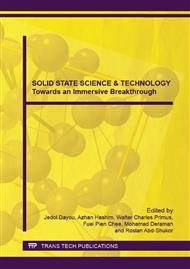p.283
p.291
p.295
p.301
p.308
p.314
p.320
p.326
p.335
Surface States and Band Gap Correlation in Silicon Nanoclusters
Abstract:
Tuning the visible emission of Si nanomaterials by modifying their size and shape is one of the key issue in optoelectronics. The observed optical gain in Si-nanoclusters (NCs) has given further impulse to nanosilicon research. We develop a phenomenological model by combining the effects of surface passivation, exciton states and quantum confinement (QC). The size and passivation dependent band gap, oscillator strength, radiative lifetime and photoluminescence (PL) intensity for NCs with diameter ranging from 1.0 to 6.0 nm are presented. By controlling a set of fitting parameters, it is possible to tune the optical band gap, PL peak and intensity. In case of pure clusters, the band gap is found to decrease with increasing NC size. Furthermore, the band gap increases on passivating the surface of the cluster with hydrogen and oxygen respectively in which the effect of oxygen is more robust. Both QC and surface passivation in addition to exciton effects determine the optical and electronic properties of silicon NCs. Visible luminescence is due to radiative recombination of electrons and holes in the quantum-confined NCs. The role of surface states on the band gap as well as on the HOMO-LUMO states is also examined and a correlation is established. Our results are in conformity with other observations. The model can be extended to study the light emission from other nanostructures and may contribute towards the development of Si based optoelectronics.
Info:
Periodical:
Pages:
308-313
Citation:
Online since:
June 2015
Authors:
Price:
Сopyright:
© 2015 Trans Tech Publications Ltd. All Rights Reserved
Share:
Citation:


